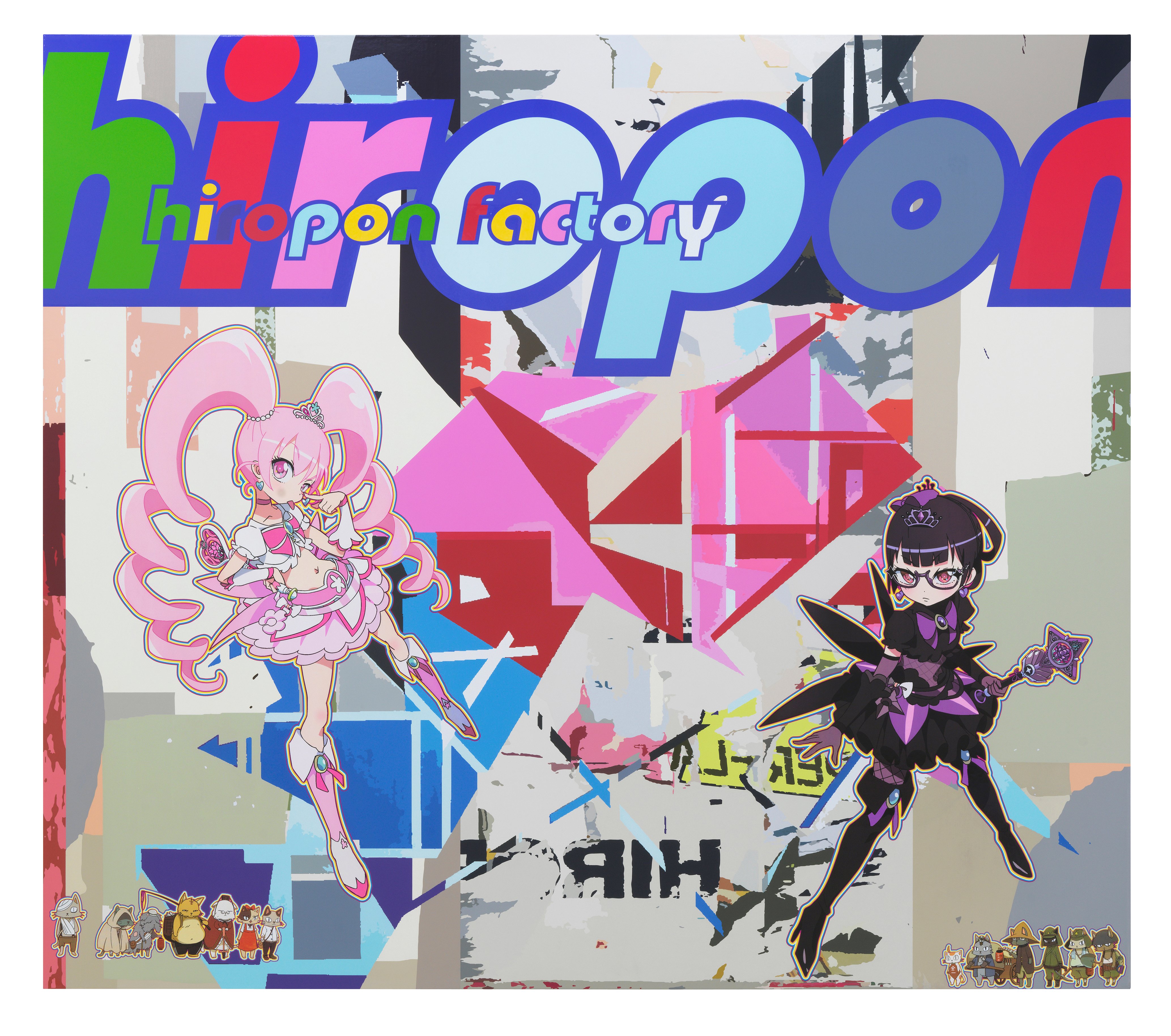
A few years ago, Takashi Murakami was scrolling through Instagram when he came across an artist he had once heard of, but had forgotten about: Michel Majerus.
That moment of predictive AI magic has led to a new collaboration between the Japanese artist and Majerus’s Berlin-based estate. (The Luxembourgish artist died in a plane crash in November 2002, when he was just 35).
Located in a quiet courtyard in the Prenzlauer Berg district, the estate preserves Majerus’s archive, releases publications, and invites artists to collaborate with the estate on exhibitions. In 2018, Jordan Wolfson curated a selection of Majerus’s home videos; the following year, works by Andy Warhol and Christopher Wool were exhibited alongside those of Majerus.
“Michel’s paintings are very dapper, without thick layers of paint and with minimum brush strokes,” the Japanese artist says in a video introduction to the exhibition, which is titled “Takashi Murakami: Michel Majerus Superflat.” (It opened on September 11 as part of Gallery Weekend Berlin.) “I was so envious,” Murakami says.
The exhibition, an unabashed homage to Majerus, includes half a dozen monumental silkscreen paintings by Murakami that remix particular works by the late artist with Murakami’s own flourishes.
Barbara-Brigitte Mak, who works for the Majerus estate, says she first came to learn about Murakami’s interest in the artist when his studio reached out with copyright questions. “It was very surprising to us,” she says. To make his Majerus-inspired works, Murakami had printed pictures off the Internet and worked from small screenshots before making several visits to Berlin to learn more about the collection and its archive.
Michel Majerus in 1996. Photo: Albrecht Fuchs, Cologne. © Albrecht Fuchs, Cologne. Courtesy Michel Majerus Estate and neugerriemschneider, Berlin.
Murakami and the West
Born in 1967, Majerus was a key member of the art scene in the post-Wall, club culture-fuelled Berlin of the 1990s. Fusing pop art with digital art, and appropriating comics, album covers, and corporate logos, he became a pioneer of the new post-analog painting that emerged in the late 1990s and early 2000s. Majerus’s colorful paintings were often haunted by slogans (“What looks good today may not look good tomorrow, now’s the time”) and his own swirling name, written in a bubble typeface. At the time of his death, he was a rising star in the German art world, and in the midst of finishing his first solo exhibition at Tate Liverpool.
Speaking from his studio in Japan, Murakami praised Majerus’s skill at “clashing cultural diversity,” and noted his references to US popular culture, which the Japanese artist is also enamored with. But Majerus was unlike Murakami in many ways: most notably, he was a prolifically talented free-hand painter.
No work of Majerus’s is on view. Instead, Murakami’s own works, all of which borrow directly from Majerus’s forms, are center stage. The backdrop for 6HP DOB Michel Majerus (2019), for example, is taken from one of Majerus’s best-known paintings, b.o. (2000), which is owned by the Berlin State Museums. Murakami has popuated it with a group of girls from manga comics and one of his signature flowers. More successful works offer new perspectives on Majerus’s work, and in particular his interests in Japanese cartoon culture and writing.
Overall, the show is more about Murakami’s own fascination and relationship with painting, and the Western art world at large, than it is about Majerus’s legacy.
“I believed I had to make some kind of statement in relation to the US, otherwise there was no point in mumbling in [a] small corner of the world,” Murakami says. Indeed, the artists are united by a generational experience: both came to prominence in an age in which digital life could be a raw material for artwork.
Considering his success elsewhere, Murakami is somewhat less revered in Germany, though this show might do well to build some more context for his thinking and reference points.
“I think Takashi understands that many people, especially in Germany, have a critical attitude towards capitalist consumerism and that critics may see him as this rather one-dimensional, commercial artist,” says the show’s curator, Tobias Berger. “However, and this exhibition proves that point, if one looks a bit deeper, one realizes how multi-dimensional and critical his works really are.”
See works from the exhibition below.
“Takashi Murakami: Michel Majerus Superflat” at Michel Majerus Estate, Berlin, 2020. © Michel Majerus Estate, 2020, courtesy neugerriemschneider, Berlin. © 2019-2020 Takashi Murakami/Kaikai Kiki Co., Ltd. All Rights Reserved. © Fujiko-Pro. Courtesy of the artist studio and PERROTIN. Photo: Jens Ziehe, Berlin
Michel Majerus’s b.o. (2000). © Michel Majerus Estate, 2020. Courtesy Staatliche Museen zu Berlin, Nationalgalerie. 2005 purchased by the Freunde der Nationalgalerie. Photo: Jens Ziehe, Berlin
“Takashi Murakami: Michel Majerus Superflat” at Michel Majerus Estate, Berlin, 2020. © Michel Majerus Estate, 2020, courtesy neugerriemschneider, Berlin. © 2019-2020 Takashi Murakami/Kaikai Kiki Co., Ltd. All Rights Reserved. © Fujiko-Pro. Courtesy of the artist studio and PERROTIN. Photo: Jens Ziehe, Berlin.
Takashi Murakami’s Doraemon’s Story of Coming and Going, (2019-2020). © 2019-2020 Takashi Murakami/Kaikai Kiki Co., Ltd. All Rights Reserved. ©Fujiko-Pro. Courtesy of the artist studio and PERROTIN. Photo: Jens Ziehe, Berlin
Takashi Murakami, Doraemon and Anywhere Door (Dokodemo Door): Happiness Is Always Being Together (2019). © 2019 Takashi Murakami/Kaikai Kiki Co., Ltd. All Rights Reserved. ©Fujiko-Pro. Courtesy of the artist studio and PERROTIN. Photo: Jens Ziehe, Berlin.
Takashi Murakami, Superflat Bubblewrap Michel Majerus (2019). © 2019 Takashi Murakami/Kaikai Kiki Co., Ltd. All Rights Reserved. Courtesy of the artist studio and PERROTIN, Photo: Jens Ziehe, Berlin.
“Takashi Murakami: Michel Majerus Superflat” is on view at Michel Majerus’s estate in Berlin through February 26, 2022.